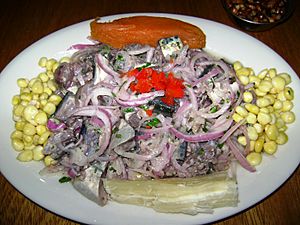Creole cuisine facts for kids
Creole cuisine is a special way of cooking that started a long time ago when different cultures mixed. The word "Creole" often describes people of European background who were born in the New World (like the Americas) and adapted to life there. It can also refer to people of African descent born in these new lands.
Creole cooking is a mix of European, African, and Native American food traditions. Imagine taking favorite dishes and ingredients from different parts of the world and blending them into something new and exciting!

You can find Creole food in many places that used to be European colonies. This includes places like Louisiana in the USA, Cuba, Brazil, Peru, the French Antilles, La Reunion (France), Jamaica, and many more. Each region has its own unique Creole dishes because they use local ingredients. However, they all share some common features:
- They often mix very different ingredients in one dish.
- The flavors can be very spicy, or a mix of sweet and savory.
- Cooking methods are usually simple, like frying or making stews (called ragout). Marinating meat (called Adobos) is also common.
In Spanish-speaking countries, many Creole dishes have names like pollo a la criolla (Creole chicken) or just use the word criollo/a, like vinagre criollo (Creole vinegar). In French, you might see à la créole or just créole, like in pâté créole.
Contents
What Does "Creole" Mean?
The word "Creole" comes from the Portuguese word crioulo, which means "to raise." In French, it's créole. This word can describe many things, but they all share the idea of mixing cultures from three continents: Europe, Africa, and the Americas.
For example, Creole languages are a mix of a European language, a Native American language, and an African language. The term can also refer to the Criollo horse, creole music, or even a popular Cuban dance.
A Creole person can be someone whose European ancestors were born in the American colonies. Or, a Creole person can be someone of African descent whose ancestors were brought to the Americas. Sometimes, it can even refer to anyone native to a Latin American country.
Creole Cuisine Around the World
Creole cuisine is found in many different places, each with its own special twist. Here are some examples:
- Argentinian Creole cuisine
- Brazilian Creole cuisine
- Louisiana Creole cuisine
- La Réunion Creole cuisine
- Caribbean Creole cuisine
- Mexican Creole cuisine
- Peruvian Creole cuisine
Brazilian Creole Cuisine
In Brazil, culinária crioula highlights the strong influence of African culture and cooking. African slaves adapted their recipes using local ingredients like mandioca (cassava) and milho (corn). They also brought ingredients from Africa, such as azeite de dendê (palm oil), cuscuz (couscous), coconut, and coffee.
One famous dish that started with African slaves is feijoada, which is now considered Brazil's national dish. Brazilian Creole cuisine is also connected to candomblé, an Afro-Brazilian religion where food is very important as a link between people and their gods. Dishes like acarajé, caruru, and vatapá are examples of this connection.
Louisiana Creole Cuisine
Louisiana Creole cuisine is a delicious mix of French, Spanish, Caribbean, African, and American cooking styles. While it shares some similarities with Cajun cuisine, they have different origins. Louisiana Creole food was developed by people of Spanish and French descent born in Louisiana. Cajun cuisine, on the other hand, came from the Cajuns (also known as Acadians), who were French settlers from Canada.
Réunion Creole Cuisine
Réunion is a small island in the Indian Ocean, near Madagascar. It was settled by people from France, Africa, India, and China. Because of this mix, Reunionese cuisine is also considered Creole. Many of its cooking traditions come from France, but the ingredients used are local to Asia and Africa, making the dishes unique and exotic.
Hispanic American Creole Cuisine
Hispanic American Creole cuisine blends Spanish and Native American elements. It uses important local ingredients like potato, tomato, and corn, which were originally grown in these regions. You can find strong Creole influences in the food of Cuba, Puerto Rico, the Dominican Republic, Central America, Colombia, Ecuador, Venezuela, Peru, Mexico, and Bolivia.
Cuba
Cuban Creole cuisine often features beans, pork, and rice as main ingredients. In the 1850s, Cuban cookbooks started to show a distinct "Cuban" or "Creole" style of cooking. Besides foreign ingredients, Cuban Creole food also uses many local products from Cuba, especially viandas. These are starchy vegetables like sweet potatoes, cassava, and green plantains. Viandas are not only tasty but also known for helping with upset stomachs.
Mexico
In Mexico, the term "Creole" has a slightly different meaning for food. It can refer to native Mexican farm products that are like "vegetable relics." This means fruits or vegetables grown locally using ancient techniques from before Columbus arrived, without changing their size, color, or flavor. Examples include Creole corn, cacao, and chili, which are considered the "purest" types.
"Creole" can also describe an imported fruit or vegetable that has changed and taken on a new form after adapting to the local climate. For example, the Creole peach is smaller, sweeter, yellower, and harder than the original peach. Sometimes, it can even refer to new hybrid varieties.
Peru
Along the coast of Peru, a Creole cuisine has also developed, influenced by Spanish, African, Italian, and Chinese cooking. One of the most famous Peruvian Creole dishes is ceviche, made with fresh fish "cooked" in lemon juice. Other popular dishes include ají de gallina, carapulca, and tacu-tacu.
See also
In Spanish: Gastronomía criolla para niños

